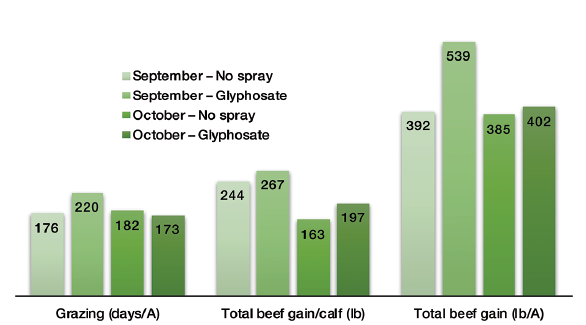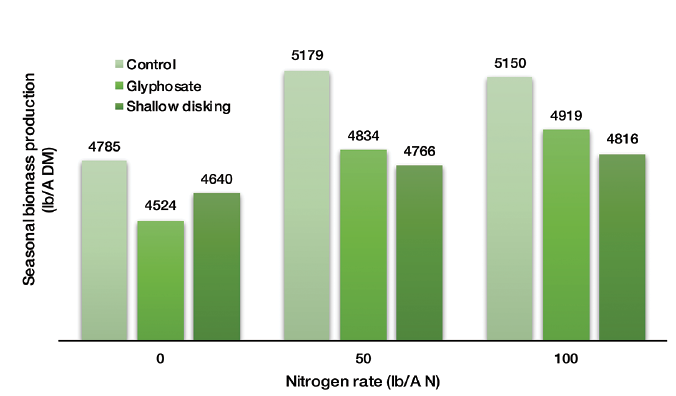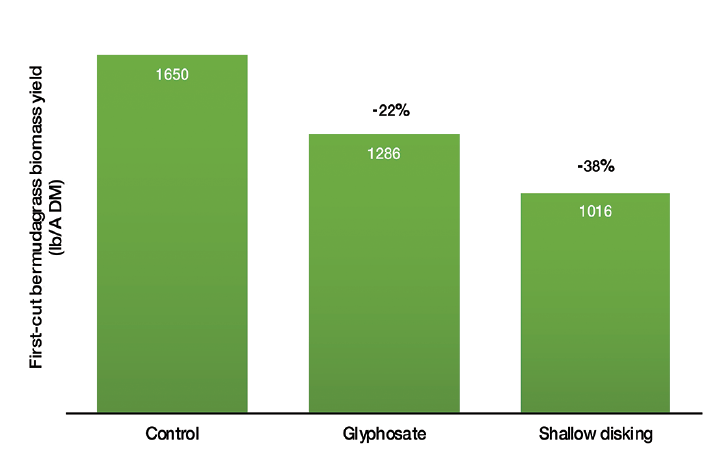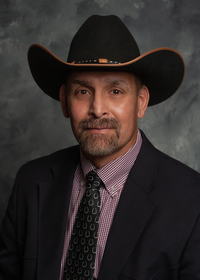Tips for Overseeding Annual Ryegrass or Small Grains into Perennial Warm-Season Pastures in the South
Overseeding cool-season annual forage crops such as annual ryegrass and small grains (cereal rye, wheat, oats, and triticale) is a widely used establishment practice in the South for grazing, baleage, or hay production. These crops can produce high-quality forage in late fall, winter, and spring, depending on the establishment method and fertilization.
They can be established using tillage or by overseeding existing pastures. The biggest challenge for managing these cool-season annual forage crops when overseeding is to manage the growth of the warm-season grass component (bermudagrass and bahiagrass) so that it does not impede the annual ryegrass or small-grain germination and establishment. The following tips can be used as guidelines to ensure a successful stand when overseeding perennial warm-season pastures:
- Take a representative soil sample, and make sure the perennial warm-season pasture (bahiagrass or bermudagrass) is grazed or clipped short (1–2 inches).
- Prepare the seed bed by lightly disking to increase seed-soil contact. After seeding, use a chain harrow or roller to make sure that all seed reaches the ground and is not stuck in the bermudagrass or bahiagrass stubble.
- Another option—the preferred option—is to use a no-till drill, which also requires that the pasture be clipped less than 2 inches. In some cases, chemical sod suppression can be applied with a burndown herbicide such as paraquat (1–2 pints per acre in 20–40 gallons of water per acre with 0.25 percent volume to volume nonionic surfactant) or a light dose of glyphosate (5–8 ounces of 41 percent per acre). Cool-season annual planting can occur 5–7 days after a glyphosate application or 1–3 days after a paraquat application. When using a no-till drill, make sure it is calibrated correctly to place the seed at the recommended depth. Research indicates that earlier planting by spraying and reducing warm-season grass competition can increase carrying capacity, animal body weight gain, and net return of overseeded warm-season pastures (Figure 1).

Figure 1. Impact of glyphosate application and planting date of cool-season annual mix (annual ryegrass and wheat) on animal performance of grazing beef calves during the 2005–2006 grazing season. For the September 2005 planting, grazing started on January 18, 2006, and for the October 2005 planting, grazing started on February 15, 2006, when pastures had accumulated 2,600 pound of forage dry matter per acre (Source: Beck et al. 2013). Figure 1 data table. Month and application
Grazing (days/A)
Total beef gain/calf (lb)
Total beef gain (lb/A)
September – no spray
176
244
392
September – glyphosate
220
267
539
October – no spray
182
163
385
October – glyphosate
173
197
402
- Plant annual ryegrass seed at 30 pounds per acre if drilling or 35 pounds per acre if broadcasting the seed. Small grains can be planted at seeding rates of 90–120 pounds per acre. Seeding rates need to be adjusted depending on whether cool-season annual forage crops are being established as a monoculture or mix. Data collected at Mississippi State University has indicated very little benefit of increasing seeding rates beyond 35 pounds per acre. On the other hand, if you use a commercial fertilizer truck to broadcast the seed, you might need to increase the rate because the truck cannot accurately spread such low amounts of seed.

Figure 2. Three-year average impact of bermudagrass sod management practice and nitrogen application on seasonal yield of annual ryegrass (Source: Evers 2012). Figure 2 data table. Nitrogen Rate (lb/A N)
Control1
Glyphosate1
Shallow Disking1
0
4,785
4,524
4,640
50
5,179
4,834
4,766
100
5,150
4,919
4,816
1 Seasonal biomass production (pounds per acre DM).
- Apply phosphorus and potassium based on soil-test recommendations. Do not apply nitrogen until the ryegrass or small grains have emerged and the plants are about 2 inches tall. Apply 40–50 units of nitrogen after emergence and then a second application of 40–50 units after the first grazing cycle if clovers are not incorporated as part of the mixture. Another nitrogen application should be made to small grains when they start to joint in late January to mid-February. Nitrogen application can help annual ryegrass production, especially when light disking or glyphosate sod suppression are implemented (Figure 2). A rule of thumb is to apply one unit of nitrogen for every grazing day. Do not mix nitrogen fertilizer with seed for two reasons: (1) depending on temperature and rainfall, it might take 7–10 days for the seed to germinate, which can increase nitrogen losses; and (2) mixing fertilizer with seed can damage the seed embryo, reducing germination and stand establishment.
- Once the cool-season annual forage crops are established, it is best to keep animals off the pasture until the plants reach a grazing height of 8–10 inches. Graze down to about 3 inches of stubble height, and remove or rotate the animals from the pasture to allow recovery.
- Remember, it is important to graze down your cool-season annual forage crops in late spring to avoid suppression of summer perennial pastures. It is best to increase your stocking rate in the spring, when annual ryegrass is at peak production. Annual ryegrass will use the available moisture and then shade the bermudagrass or bahiagrass just as it is trying to break dormancy. The result is a severely weakened, suppressed stand of bermudagrass or bahiagrass with lower yield potential. One source reported that bermudagrass recovery is delayed more by the shallow disking (1–2 inches) than by using a low glyphosate rate (Figure 3).

Figure 3. Three-year average impact of bermudagrass sod management practice on first-cut bermudagrass yield recovery after annual ryegrass planting in October (Source: Evers 2012).
References
Ball, D. M., Hoveland, C. S., & Lacefield, G. D. 2015. Southern Forages (5th ed). International Plant Nutrition Institute.
Beck, P., Gadberry, S., & Jennings, J. (2013). Using cool-season annual grasses for grazing livestock. University of Arkansas Cooperative Extension Service.
Evers, G. (2012). Effect of autumn sod treatments on overseeded annual ryegrass production and coastal bermudagrass recovery. Crop Science, 52(3), 1430-1436.
Publication 3255 (POD-09-24)
By Rocky Lemus, PhD, Extension/Research Professor, Plant and Soil Sciences.
The Mississippi State University Extension Service is working to ensure all web content is accessible to all users. If you need assistance accessing any of our content, please email the webteam or call 662-325-2262.



